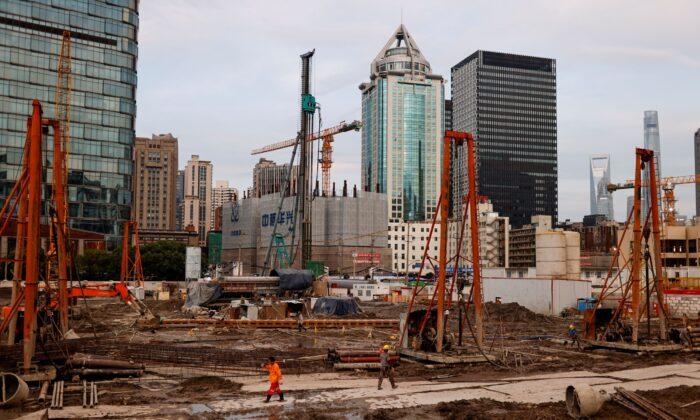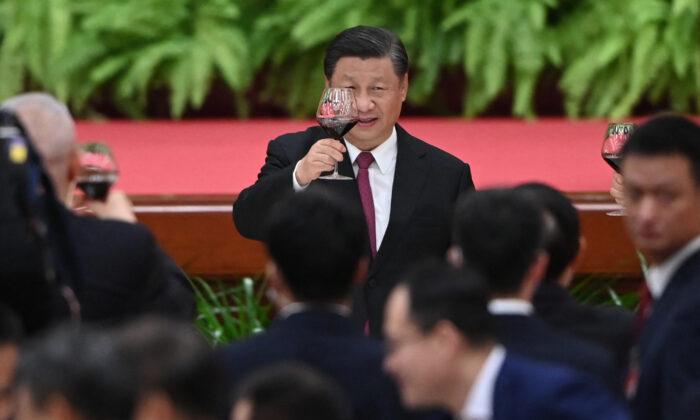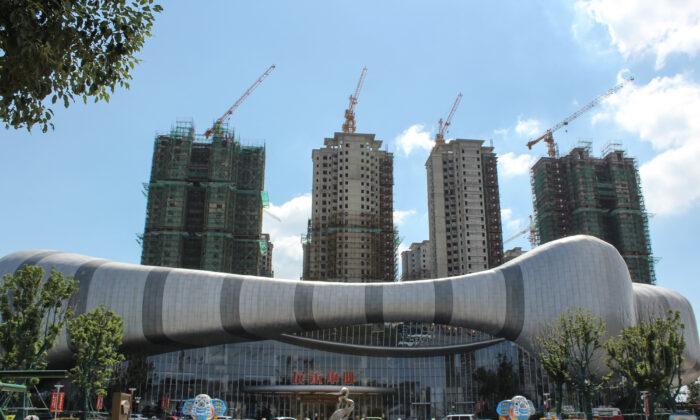The news of the financial crisis of real estate giant Evergrande Group is a shock to China’s consumers. Its shares took a serial decline in the Hong Kong stock market. Consequently, it drew the attention of Wall Street investors. How long can Evergrande last?
Is it the beginning of China’s real estate industry slipping into crisis after more than two decades of prosperous development?
Boom and Bust of China’s Real Estate
China’s economic growth and prosperity in the past 20 years mainly relied on the booming of exports and construction projects.Since China became a member of the World Trade Organization (WTO) in 2001, the surge of foreign capital flowing in has since brought its export growth to more than 25 percent annually. The booming of exports drove Chinese economic growth for 10 years.
While the regime enjoyed economic growth, it overlooked a problem: China has a big population and the global market is too small.
China’s labor force accounts for 26 percent of the global employment population. Even if China occupied the entire global market and all industrialized countries stopped exporting, the export boom couldn’t go on indefinitely.
From the perspective of international economic balance, trade must be mutually beneficial. The phenomenon of China’s export boom—earning all of the world’s money, selling more and buying less, and accumulating huge foreign exchange reserves—will eventually end.
In order to maintain high economic growth, China promoted infrastructure construction and real estate development, thereby stimulating a round of booming construction projects.
The construction investment share in GDP rose to 20 percent from 18 percent before 2008, to 35 percent in 2013 and 2014. Although the construction boom has supported Chinese economic growth for another 10 years after the export boom, a real estate bubble has quietly formed.
During the Heisei economic bubble in Japan, real estate investment accounted for only 9 percent of Japanese GDP. During the 2008 U.S. subprime mortgage crisis, this ratio was only 6 percent.
If we compare the ratio of real estate investment in GDP, China’s real estate bubble is equivalent to twice the size of the Heisei economic bubble in Japan, and the real estate bubble during the U.S. subprime mortgage crisis is only a fraction of China’s real estate bubble.
The construction boom has turned real estate into the leader and pillar of China’s economy in just 10 years, driving dozens of upstream and downstream industries.
During the peak, China consumed more cement in three years than the United States consumed in the entire 20th century; crude steel production capacity increased to 1.16 billion tons at the end of 2014 (equivalent to 69 percent of world crude steel production) from 660 million tons in 2008 (equivalent to 49 percent of the world’s crude steel output).

Devastating Effect of New Financing Deals for Developers
Local government income has relied heavily on land sales for real estate development. This high dependence has local governments worried about the real estate bubble bursting. And a large amount of commercial banks’ funds have been invested in projects or home buyers’ mortgage loans. Thus, banks are more afraid of the real estate bubble bursting than local governments. Once the real estate bubble bursts, the bank’s bad debts will rise sharply.Beijing authorities have been facing an economic policy dilemma since 2017: to curb the overheating real estate market or to prevent the real estate bubble from bursting.
When the economy was initially hard hit by the pandemic, the regime began to suppress the real estate hype due to three factors.
First, more and more urban households curbed consumption because of expensive housing and heavy mortgages.
Second, the local government’s reliance on land transfers as a source of income is unsustainable. Real estate tax is an alternative source of income for local finances. Once the real estate tax is introduced, people who own multiple properties would sell them in order to avoid paying the levy. A large number of second-hand properties will flood the housing market and house prices are bound to fall, which will induce a financial crisis for the banking industry.
Third, Chinese banks have constantly poured huge amounts of money into home developers and buyers. But if home prices drop significantly and real estate developers go bankrupt, the banks will collapse and the regime won’t be able to bail them out.
According to the new financing policy for home developers, no loans will be granted if all three lines are crossed; the debt can be raised as much as 5 percent a year if two lines are crossed; a 10 percent debt increase is allowed if one line is crossed; a maximum of 15 percent debt can be raised if no lines are crossed. That means the bank loan is capped at 15 percent for the best-performing home developers, and the bank loan is cut off for home developers who fail to improve their finances.
The Downfall of Evergrande
Evergrande Group is China’s leading property developer and ranked 122nd in the Fortune Global 500 this year. Its financial crisis doesn’t only concern Beijing, but also many investors at home and abroad.Evergrande once had a glorious history. On top of its real estate, it owned the best professional soccer team in China, an electric car unit, and many financial products. But even such a strong property developer is vulnerable in the face of the new refinancing rule. A large number of debt collectors gathered at the company’s headquarters in Shenzhen last week.
At present, Evergrande’s liabilities totaled more than $310 billion, of which $88.63 billion are interest-bearing liabilities, and 42 percent of which will mature in less than one year; cash and equivalents on the books are only $13.4 billion, on top of 460 billion real estate properties and 146 home projects, mainly in the Pearl River Delta, of which 62 are in Shenzhen. Measured by “the three red lines,” Evergrande’s operating conditions are in jeopardy. Its financial status has crossed all three red lines and thus, it’s banned from receiving additional bank loans.
Since the new policy took effect, Evergrande’s effort to sell homes has been unsuccessful. Amid the economic downturn and regulatory crackdown on the real estate industry, the company hasn’t gone bankrupt yet. However, there are no buyers, and other large real estate companies are also short of cash or worried about stagnant sales.

Evergrande made the mistake of excessively expanding its operations in the past while miscalculating Beijing’s policies. Since the central bank of the Chinese Communist Party (CCP) has tightened monetary policy this year, even if Evergrande became free of the three red lines, no banks would dare to grant refinancing to Evergrande. Now that Evergrande is short of cash and has crossed all the red lines, the bank can only cut off the loan.
It’s the CCP’s Economic Struggle
The CCP won’t abandon Evergrande. After all, Evergrande’s bank loans come from several large state-owned banks. If Evergrande collapses, these banks might not go bankrupt, but they will suffer.However, with the gradual decline of national real estate prices, many cities have implemented the highest sales with a reference price of 30 percent off the market price. Evergrande’s properties and projects are bound to depreciate even further.
Evergrande was hard hit on Sept. 13 when the local government in Nanhai district of Foshan city, Guangdong Province, suspended mortgage loans for Evergrande’s properties, effective immediately. The company has nine local projects, and this ruling disqualified home buyers from getting mortgage loans from local banks. That means Evergrande won’t be able to sell properties in the district. If other local governments follow suit, Evergrande will be ruined.
Evergrande is China’s first giant on the verge of collapse, and China’s chain of corporate and financial crises is likely emerging. Praises that blindly boast about China’s economy are no longer tenable. The poor prospects of China’s economy will only frustrate those pro-China Wall Street brokers—their desire to improve the U.S.-China economic and trade relations will also start to fade.
The CCP Desperately Needs Washington’s Help
After President Joe Biden and Chinese leader Xi Jinping spoke on the phone, the CCP’s foreign propaganda media DW News published a report headlined, “The Implication of Xi Jinping and Biden’s Talk.” That article tells us that the CCP is in desperate need of relieving its economic crisis by improving China–U.S. relations and lifting all U.S. sanctions.The article revealed that Beijing is losing its patience with the Biden administration’s indecisiveness and strategic ambiguity regarding its China policy.
“Xi urged Biden ... bring bilateral relations back to the right track of steady development as soon as possible ... to demonstrate strategic vision and political courage,” DW News reported, citing a Xinhua article.
The article also stated that Biden is “taking small steps, wobbling on the way to restore China–U.S. relations ... this is too conservative ... can the China–U.S. civilian trade afford it?”

Will Team Biden carry out the CCP’s demands? We'll know the answer in the next few months.





